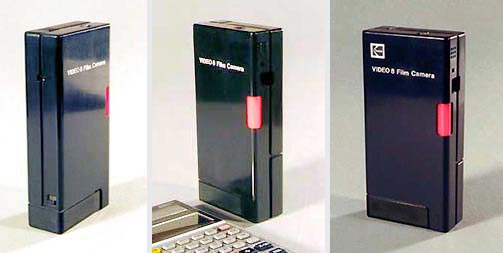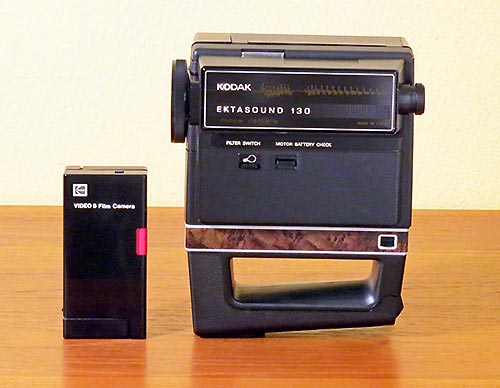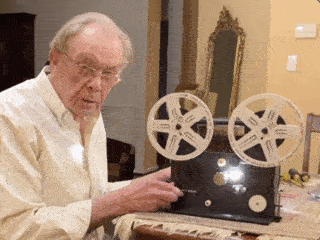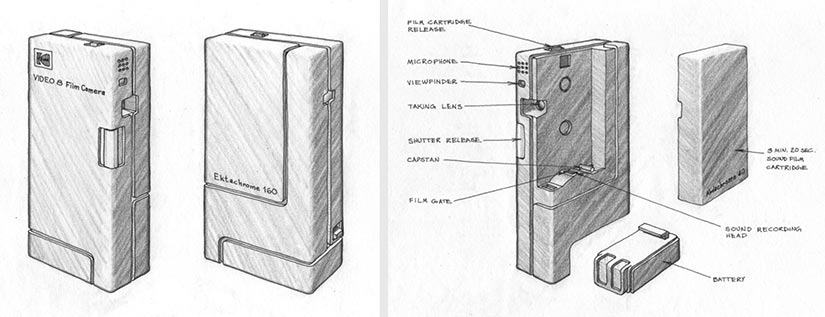Pocket Movie Camera
Pocket Movie Camera
Smaller and quieter than any other 8mm movie camera.
010 A silent-running, shirt-pocket sound movie camera developed by Steve Hines at the Kodak Research Laboratories in 1976. The design goal was to develop a pocketable movie camera to encourage filmmaking.
020 The 5-oz. Pocket Movie Camera beside the 3-lb. Kodak Ektasound 130
The smallest 8mm movie cameras available in 1976:
 |
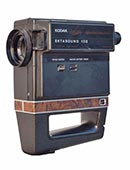 |
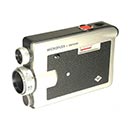 |
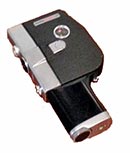 |
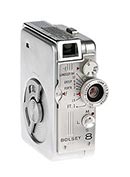 |
|
| Kodak pocket sound movie camera | 040 Kodak Ektasound 130 | Agfa Microflex Sensor | Fujica P1 | Bolsey 8 | |
| Film format | frame size of Super 8 | Super 8 sound | Super 8 | Single 8 |
Standard 8 |
| Run time- min. | 3-1/3 | 3-1/3 | 3-1/3 | 3-1/3 | 2 |
| Frame rate | 15 fps | 18 fps | 18 fps | 18 fps |
16 fps |
| Shutter angle | 360° | 230° | 180° | 160° | ≈ 150° |
| Duty cycle | 100% | 63% | 50% | 44% | ≈ 42% |
| Weight, grams | 142 | 1250 | 500 | 530 | 400 |
| Volume, cu. in. | 10 | 180 | 31.5 | 31.5 | 11.1 |
| Camera operating noise | as quiet as a tape cassette player | usual chatter of intermittent film pull down | usual chatter of intermittent film pull down | usual chatter of intermittent film pull down | usual chatter of intermittent film pull down |
| Microphone | built in | external | — | — | — |
The pocket movie camera does not use the typical intermittent film pulldown or a blanking shutter between frames. After an internal lens cap is opened for each shot, the camera is always exposing frames. A faceted mirror causes the image to continuously chase moving film, giving the equivalent of a 360° shutter. The sound-recording head is at the film gate, so there is no time gap between the picture and sound if edited.
| 80 The pocket movie camera uses 8mm wide, unperforated mag-striped film, similar in flexibility to audio tape. Instead of perforations, the camera exposes an optical fiducial mark beside each frame, used by the Kodak VP-1 video film player for playback on a television. | 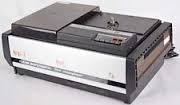 |
|
Proof-of-concept test projector:
090 Steve Hines operating the non-intermittent projector, built before developing the pocket movie camera. Viewers watch movies without the chattering noise from a projector, or camera noise recorded on the soundtrack. |
|
When the projector is operating, and when the camera is taking pictures, there is no blanking shutter to darken the picture.
100 The size is kept to a minimum by attaching the film cartridge and battery to the outside of the camera to complete the form. The quiet-running film transport made it possible for the microphone to be built in.
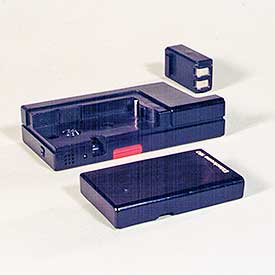 |
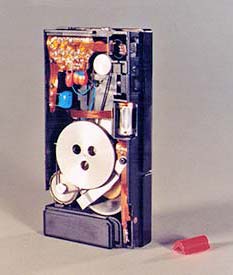 |
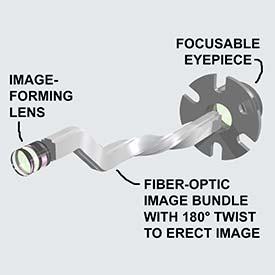 |
| 110 The camera with film cartridge removed, showing capstan drive, film take-up drive, taking lens, shutter release, viewfinder opening and focus, film gate, and sound recording head. | 120 The battery, shutter release, flywheel, taking lens, faceted mirror, motor, speed regulator, fiber-optic viewfinder, microphone, and sound amplifier on folded flex circuit. | 130 The fiber-optic viewfinder, is twisted 180° to create an erect image for the eyepiece, and is shifted to clear parts in the camera to place the eyepiece on the center of the camera. |
Pocket Movie Camera Specifications:
- Size: fits in a shirt pocket
- Weight: 5 oz. (142 grams).
- Built-in microphone, automatic gain control.
- Lens: 10mm FL, ƒ3.5.
- Film load: 3-1/3 min.
- Frame rate: 15 fps.
- Film type: un-perforated, 8mm mag-striped, capstan driven.
- The film being unperforated, reduces cost.
- Shutter angle: 360° open.
- Exposure: automatic.
- Viewfinder: fiber-optic image bundle.
- Eyepiece: focusable.
- Film type and ASA: keyed to camera by film cartridge.
- Operating noise level: similar to a cassette recorder.
The pocket movie camera may not seem that small; however, to put it in context, this camera was developed in 1976 when:
- TV news was shot on 16mm B/W film.
- 5 years before the IBM PC.
- 6 years before music CD’s.
- 8 years before the first 8mm camcorder.
- 19 years before GPS navigation in cars.
- 31 years before the iPhone.
Comments:
“I was very impressed by the ingenuity that went into this device… So many clever ideas in such a small package! My hat is off to you.” Andy Baird, Oct. 3, 2019
In a meeting of the Kodak president and V.P.’s, I showed the camera to President Walt Fallon who turned to Les Quigley, VP of manufacturing, and said “I’m going to hang a picture of this over your desk”. Nov. 1976.
Why it was not put on the market:
During the camera’s development, competing video cameras were coming on the market. As a further hurdle, the pocket movie camera required a new film format. Interest in video had become too strong to create a new film format.
Once Kodak business confidential, this technology by agreement between Eastman Kodak and HinesLab is available for license from HinesLab. For any questions, please contact Steve Hines at:

